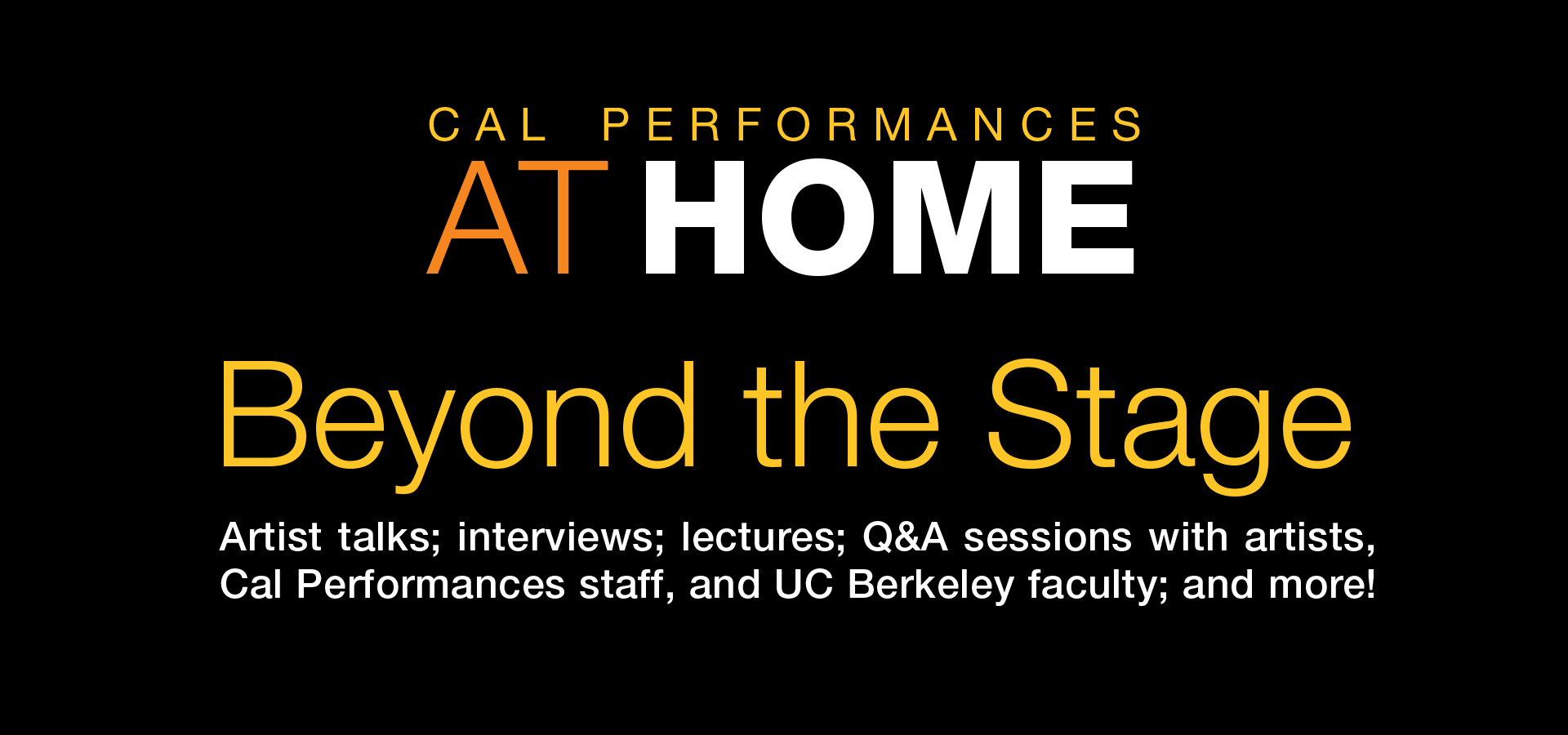
Cal Performances at Home is much more than a series of great streamed performances. Fascinating behind-the-scenes artist interviews. Informative and entertaining public forums. The Cal Performances Reading Room, featuring books with interesting connections to our Fall 2020 programs. For all this and much more, keep checking this page for frequent updates and to journey far, far Beyond the Stage!
Major support for Beyond the Stage is provided by Bank of America.
Beyond the Stage
Q&A: The Making of Kodo’s One Earth Tour 2025: Warabe
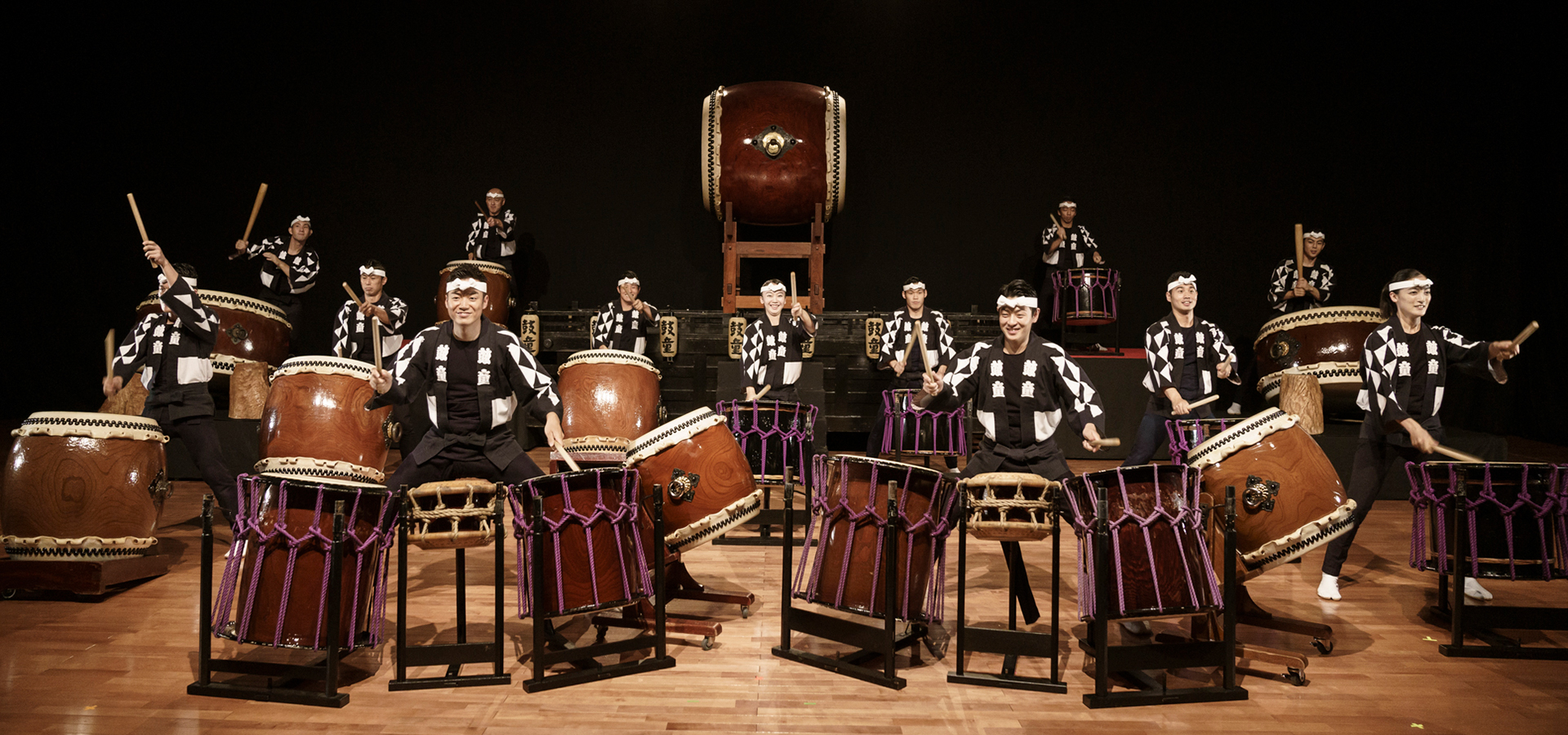
Q&A: The Making of Kodo’s One Earth Tour 2025: Warabe
“We want to think through what we want to portray in every piece, [physical] movement, and sometimes even breath.”
Interview of Taiyo Onoda, Kodo troupe member, by Kimia Adibi, Cal Performances’ PR Assistant
For 40 years, Kodo has evolved the ancient art of taiko drumming through rigorous physical discipline and spiritual connection while maintaining deep roots in Japanese cultural heritage. When the group returns to Cal Performances January 25 and 26 for One Earth Tour 2025: Warabe, audiences will see San Francisco native and UC Davis alumnus Taiyo Onoda performing with them.
In a recent conversation with Cal Performances PR Assistant Kimia Adibi, Onoda offered his insight into the behind-the-scenes of Kodo.
Q: Kodo’s 40th anniversary productions, Tsuzumi (which came to Cal Performances in 2023) and Warabe (coming to Cal Performances this month), each explore different facets of Kodo’s identity—one centered on the drum itself, the other on maintaining a child’s perspective. What inspired this dual exploration?
A: Our ensemble name “Kodo” is a coined term, which consists of two kanji characters. The kanji character for “Ko” can be read as “Tsuzumi,” and the kanji character for “Do” can be read as “Warabe.” Thus, we identify ourselves as “Children of the Drums.” We want to explore the limitless potential that taiko has, with the spirit similar to the never-ending curiosity that a child has.
Q: Kodo’s performances are known for their physical and spiritual intensity. How do the artists prepare, both individually and as an ensemble, to create such a deep connection with audiences?
A: Individually, we prepare for production rehearsals by digging through our database of past recorded performances. The next crucial step is to communicate with everyone to polish the pieces. For example, we can ask the composers of pieces if there were any specific instructions to keep in mind when performing. We also talk with the artistic director to have a better understanding of the atmosphere we want to create in certain scenes. But many things can change once the ensemble practices start due to aspects like team chemistry, and updated “trends,” to name a few. We want to think through what we want to portray in every piece, [physical] movement, and sometimes even breath. We need to analyze and understand what we as an ensemble want to perform in order to have a deep connection with the audience.
Q: The holistic experience of a Kodo performance is extraordinary. How does the company work with venue acoustics, spatial arrangements, and staging elements to create this immersive atmosphere?
A: We have our stage setup and soundcheck routine meticulously orchestrated. We have performing members sit in the audience to give instructions on how to place certain props or instruments on stage to utilize the whole stage, on every single performance on tour. We also have performers listen to pieces during rehearsal to give the others on stage feedback of the sound we create. We can then adjust how we play our instruments by relying on our ears and tactile feedback, and memorize them for our actual performance. However, that cannot be perfectly recreated because having all the audience sitting in the theater changes the acoustics slightly, and the audience may respond to our performance in certain ways. We listen and feel for those responses and reactions we get in our actual performance and may possibly make subtle adjustments in real time.
Q: Many of Kodo’s pieces incorporate physical interactions between performers as well. How do you develop these movement sequences?
A: Movements in a piece, like dances, are choreographed. There is constant communication between the drummers and the dancers when creating the piece. The movements themselves are mostly borrowed from folk/festival pieces from all around Japan, and especially from our home island of Sado. For example, the dance movements in the piece “Okoshi” incorporate movements from traditional folk arts native to Sado Island, categorized as oni daiko, or ondeko. Every village on the island has their unique style of ondeko, and when creating this piece, we visited the villages to learn their local ondeko dance.
Movements that happen outside of pieces, like moving drums from one place to another, or even simply walking on stage, are not necessarily choreographed. However, because we have communicated all the minute details of how we want to perform, we all have a general consensus of how we should be moving on stage in certain scenes.
Q: Kodo’s Earth Celebration festival, designed to create “an alternative global culture through musical and cultural collaborations,” has become Japan’s longest-running music festival. How has creating this artistic meeting space over the years influenced Kodo’s own artistic development?
A: We believe that constant collaborations with other artists are essential for our growth. As professional performers, we want to hone what we have already, but it is equally important to input new ideas and concepts from artists aside from Kodo in order to create something new. We are an ensemble that explores the limitless possibilities of taiko. We hope to further expand our knowledge of taiko by looking through a different lens, which is made possible in such collaborations.
———–
Cal Performances presents One Earth Tour 2025: Warabe, Saturday, January 25 at 8pm and Sunday, January 26 at 3pm at Zellerbach Hall. Learn more about the performance and how to attend.
Related Posts
There are no related posts yet. Check back soon!
Judith Jamison’s Life and Legacy—at Zellerbach Hall and Around the World
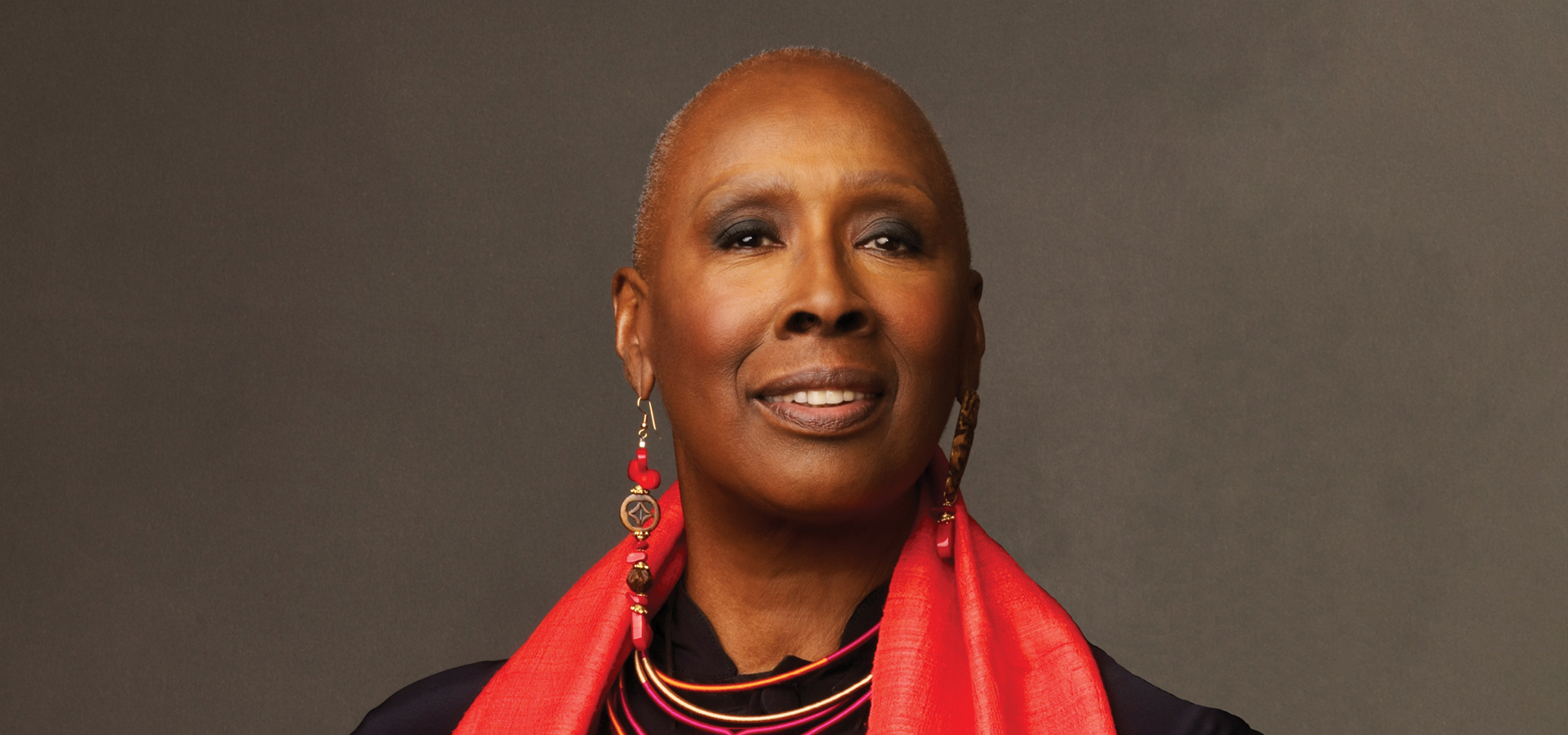
Judith Jamison’s Life and Legacy—at Zellerbach Hall and Around the World
“She taught me a lesson, too. When you put something out there, you have to go for it, stay on it, and stick to it.”
By Krista Thomas, Cal Performances Interim Director of Communications; with special thanks for the contributions of Robert Cole and Sylvia Lindsey
Photo: Judith Jamison. Photo by Andrew Eccles.
In November 2024, the world lost a dance legend. Celebrated for her talents as a performer, choreographer, company leader and founder, and overall visionary, Judith Jamison has had an international reach, and inspired many generations of dancers and dance-lovers. And, though her impact was elevated to a global scale, it is felt intimately here at Cal Performances as well.
Ms. Jamison was born in Philadelphia, Pennsylvania, in 1943 and, by her own account, was “filled” with the arts as a child, both as an audience member and practitioner. Her formal dance training began at age six and blossomed into a career that, in her early 20s, would land her a role as company member at Alvin Ailey American Dance Theater.
While Ms. Jamison had been a remarkable dancer since the beginning of her time at the company, it was six years after she joined that she starred in the work that would propel her to international stardom: Alvin Ailey’s “Cry” (1971). Created in only about one week as a tribute to “all Black women everywhere — especially our mothers,” the work saw Ms. Jamison—for and alongside whom the work had been developed— in a solo role, embodying generational hardships and unmatched perseverance. According to Ms. Jamison, “In my interpretation, she [the dancer] represented those women before her who came from the hardships of slavery, through the pain of losing loved ones, through overcoming extraordinary depressions and tribulations. Coming out of a world of pain and trouble, she has found her way—and triumphed.”
Her deeply emotional performance was met with significant enthusiasm. The New York Times review from the following evening reported, “Because ‘Cry’ is a solo, even though a formidably long one [15 minutes], its importance could easily be overlooked. But it certainly wasn’t by the first-night audience, which applauded and cheered it for nearly 10 minutes.”
From 1965 until 1980, Ms. Jamison saw her career grow even further. During this time, she remained at Alvin Ailey American Dance Theater and performed many works as a company member as well as alongside other national and international dance companies (especially ballet companies) as a guest performer. In 1980, she temporarily left the company to pursue other ventures, including performing on Broadway and founding her own company, the Jamison Project, through which her output as a leader and choreographer flourished.
Ms. Jamison returned to Alvin Ailey American Dance Theater in a leadership position in 1988 and assumed the title of artistic director in late 1989 following the passing of the company’s founder and her longtime artistic collaborator, Alvin Ailey. In 1993, Ms. Jamison choreographed Hymn as a tribute to “Mr. Ailey’s incredible contributions to dance and humanity,” per the company.
Ms. Jamison’s tenure as artistic director of Alvin Ailey American Dance Theater lasted from 1989 until 2011. During that time, she choreographed many renowned works, secured a permanent home for the company, asserted the significance and expanded the influence of Mr. Ailey’s legacy, and oversaw the growth of AileyCamp to inspire middle school children through dance.
At the time Ms. Jamison began leading the company, Alvin Ailey American Dance Theater had already been performing at Cal Performances annually, though generally only for a few performances during each engagement. It was with Ms. Jamison that Cal Performances cemented a much stronger partnership that would span 7+ performances each season, eventually making Cal Performances the company’s most performed-at venue outside of New York. What is fondly referred to as “Ailey Week” at Cal Performances has become a beloved tradition. What is more, the company’s pronounced presence across each season has undoubtedly given shape to Cal Performances’ overall dance profile and, as a result, has shaped the ways our Bay Area community has come to experience life-enhancing dance performance.
Robert Cole, who was Cal Performances’ artistic director for much of the same time that Ms. Jamison led Alvin Ailey American Dance Theater, reflected, “Judith was a very strong leader. She had a driven personality, which I related to and appreciated. But I think the main thing about Judith, why she was so successful: her gift was that she shared Ailey’s vision. She shared it, and she made it grow.”
At Cal Performances, this growth was visible not only in the increased frequency of engagements with the company, but also through the creation of Berkeley/Oakland AileyCamp, which will celebrate its 23rd year next summer. AileyCamp was developed by Mr. Ailey in his final year of life as a free summer program for middle school children that uses dance as a means of teaching personal development. Along with classes in company repertoire and styles like ballet and African dances, the program teaches positive self-image, conflict resolution, and self-expression, among other invaluable skills. At the time that Ms. Jamison assumed leadership of the company, AileyCamp was just getting its legs. However, Ms. Jamison was incredibly dedicated to extending opportunities to the youth, and invested her energy into seeing this program expand. In recent years, she shared, “I was filled as a child, so that’s what’s so important to me still to this day—will always be—that children see it [the arts]… because if they don’t have my background but they get a chance to see, in a theater, live people trying to convey spiritual art to you… it’s wonderful, because they have a whole other world open to them.”
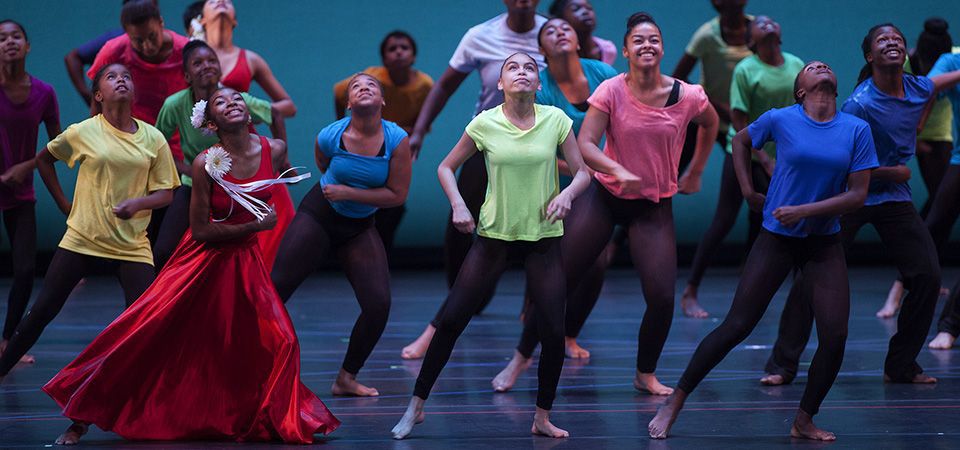
AileyCamp dancers on stage in the Final Performance at Zellerbach Hall
Sylvia Lindsey, who has been a longtime supporter of arts throughout the Bay Area and especially of Berkeley/Oakland AileyCamp, recalled Ms. Jamison’s vision and ensuing determination to get an AileyCamp on the West Coast. “She was motivated because she saw what AIleyCamp was already doing elsewhere, and she wanted a camp on the West Coast. The company was coming to Cal Performances every year already. She was the first person who talked to me about AileyCamp, and I remember her saying something like, ‘I know we can get this camp here.’” And in 2002, thanks to the support of Ms. Jamison and the Ailey company, numerous dedicated donors and community advocates and trustees—most notably Ms. Lindsey, Maris Meyerson, and Susan Marinoff—and a “wonderful [Cal Performances] staff” who could support the vision, per Mr. Cole, Berkeley/Oakland AileyCamp officially launched.
Ms. Lindsey, who considered Ms. Jamison a friend and inspiration, shared that, through this process, “She taught me a lesson, too. When you put something out there, you have to go for it, stay on it, and stick to it.” Ms. Lindsey recalls Ms. Jamison being steadfast in checking in on the program’s development, and personally invested in the camp’s success.
Since Berkeley/Oakland AileyCamp’s founding, the camp has impacted more than 1,300 individuals, and AileyCamp more broadly has expanded to serve 10 cities across the country. So much of what we know and admire from Alvin Ailey American Dance Theater today was intentionally nurtured by Ms. Jamison’s visionary leadership. And as a result of her singular and exceptional work—her choreography, her artistic guidance, her investment in the Ailey company and dancers of the present and future—we can see a real human impact.
Ms. Lindsey said, ”She was such an interesting and delightful person to know. A no-nonsense person; a genuine, for-real person. She has left a legacy, and especially for all young Black women—and for all women, period.”
Though Cal Performances’ current Executive and Artistic Director Jeremy Geffen did not know Ms. Jamison personally, he has been touched by the legacy she has left at Cal Performances and beyond, and the ways that she has supported the healing power of the arts for decades. Giving voice to the sentiments that many admirers of the icon have shared since her passing, Mr. Geffen shared, “To say that Judith Jamison was a trailblazer is an understatement. A role model for generations of dancers, an inspiration for audiences, and a beacon of light in an often dark world, she made us all better through the brilliance of her talent, leadership, and strength of character. Cal Performances will always view her as part of our family, and she will continue to inspire us for decades to come.”
Alvin Ailey American Dance Theater has dedicated its entire current season to Ms. Jamison, and Cal Performances is dedicating April 2025 Ailey Week and AileyCamp to her legacy as well.
Related Posts
There are no related posts yet. Check back soon!
What Makes Bach’s Sonatas & Partitas for Solo Violin Significant?
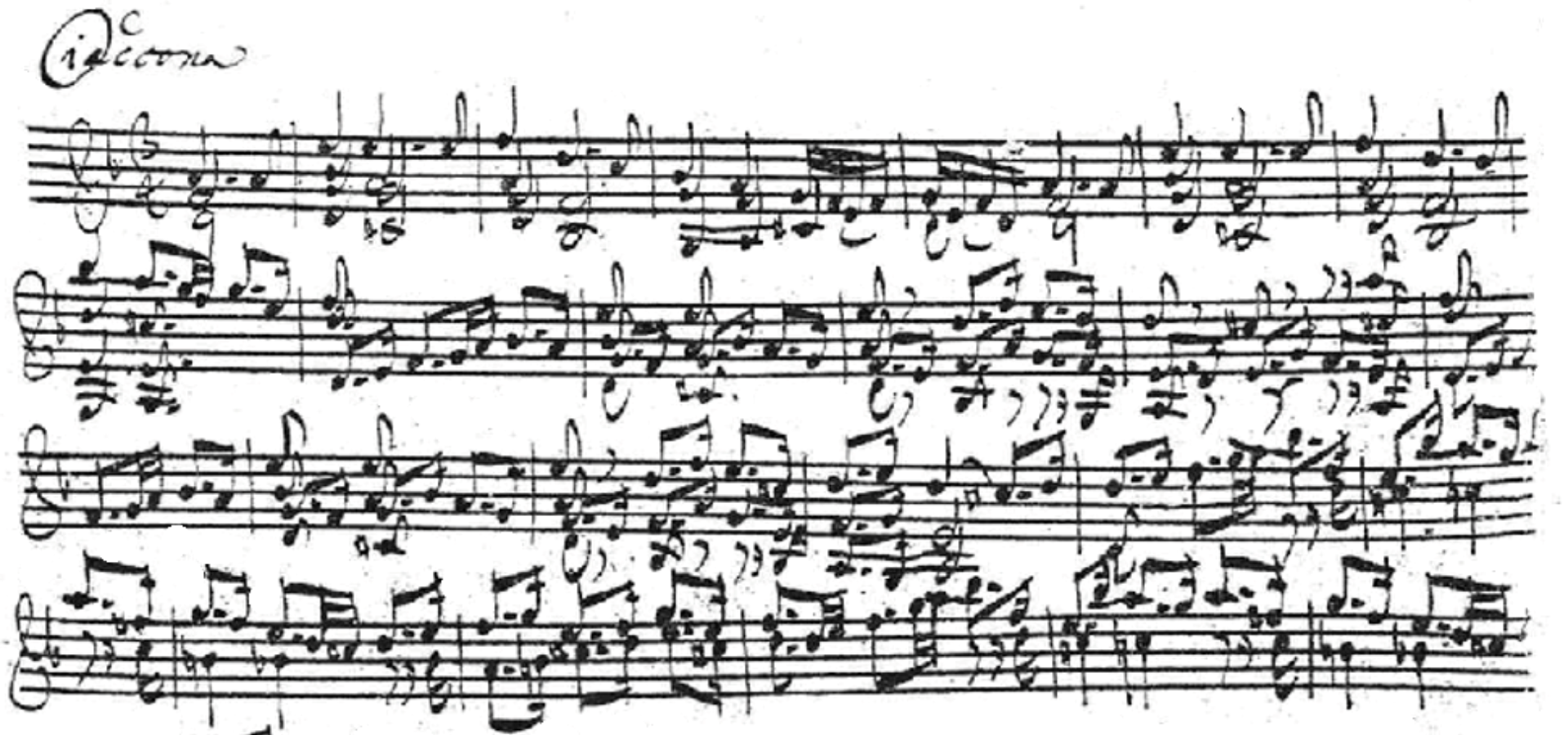
What Makes Bach’s Sonatas & Partitas for Solo Violin Significant?
“You’re witnessing something grand, and a personal communion simultaneously.”
Video editing by Tiffany Valvo, Cal Performances’ Social Media and Digital Content Specialist; Music bed: Leonidas Kavakos, Bach’s six Sonatas & Partitas for Solo Violin, Various
Considered both an invitation and a challenge to violinists, Bach’s Sonatas & Partitas for Solo Violin come with a title—“Sei Solo”—that in Italian both describes the work itself (“Six Solos”) and acts as a sobering reminder to the player (“You are alone”). Ahead of Leondias Kavakos’ performance of these works in November 2024, Cal Performances’ Executive & Artistic Director Jeremy Geffen breaks down what makes these works so notable and why hearing Kavakos play them is a special opportunity. Geffen covers:
- 00:00 Intro
- 00:43 What is so significant about these works?
- 1:33 What’s a sonata?
- 3:48 What’s a partita?
- 4:53 What makes hearing Leonidas Kavakos playing these pieces so special?
- 5:37 What’s your favorite movement?
Transcript
Jeremy Geffen:
It is some of the most moving music ever created. And there’s also something about the visual of one person up on that stage with a little thing right here, two little things making all of this sound, all of this expression, and creating something that is just enormous and completely intimate, something grand and a personal communion simultaneously. Bach’s six Sonatas and Partitas for Solo Violin occupy a particularly vaunted position in the classical music repertoire overall, but specifically in the life of any violinist and actually most string players. Violinists spend their entire careers coming up with their approach to these pieces. Any time one has the opportunity to hear all of these pieces together is a major moment. And to have Leonidas Kavakos, who is accepted as one of the greatest violinists of our time, come here and play these on our stage means a great deal to this community, certainly to me. And it’s something that I’ve been greatly looking forward to as we plan the season.
The term “sonata” actually just comes from a Latin word that means “to sound.” We tend to think of the romantic sonatas being in three movements: fast, slow, fast. That was not the form that Bach used. And, in fact, over the course of his career, he basically stuck with a four movement sonata: a slow movement, a fast movement, a slow movement, a fast movement. The first fast movement in those sonatas is always a fugue. And Bach was pretty well associated with fugue, still is today. [Learn more about Bach’s fugues.] He was a master of counterpoint. These are not short pieces. The fugue in the third sonata, the C major sonata, is an 11-minute work. It is the type of 11-minute work where you think, “Please get that guy some Gatorade afterwards,” because it is so taxing that these sonatas have some of the most deep, slow movements. Sometimes in the slow movement of the third sonata, they’re quite simple and direct, and sometimes he’s taking you into a very complicated emotional landscape, which is all the more remarkable because they’re not very long movements. So what he’s able to accomplish in this very small frame is a testament to the genius of the composer. And then I think about the last movements of these pieces. The last movement of the A minor, the second sonata, or of the C major, they are so full of joy. I mean the C major one, you’ll burst out of your seat. There is a type of exuberance in the human experience that is infectious, and it makes you wonder about the complexity of the human being that was able to write such a variety of works.
Partitas are a slightly different story. The term “partita” really refers to a collection of dances. He takes a different approach with each one of the three partitas. The first partita, the B minor, consists of four movements, and then he goes somewhere completely different with the D minor partita. Now the D minor partita, the second partita, contains perhaps the most famous movement in all these six pieces and one of the most famous pieces that Bach wrote overall, which is the 13- to 15- minute chaconne that ends the piece. It’s sort of like a Baroque cathedral in a violin form. He is building this extraordinary structure. You’re witnessing something grand and a personal communion simultaneously.
Leonidas Kavakos is no stranger to Berkeley. Over the last 15 years, has come into his own, not only as a violinist, but as a conductor. He is one of the most extraordinarily generous, funny, kind people I’ve worked with offstage. And that generosity of spirit combined with this incredible violin ability that allows him to transmit every idea he has in the way that he wants to makes him unique among performers today.
I would say that my answer to that [Which is your favorite movement?] really depends on the moment. There are… I think there’s a movement for every mood. It’s hard not to single out the chaconne because it has everything in it, and somehow it fills me up every time I hear it. But there are others. The prelude to the third partita, the last movement of the C major sonata, the slow movement of the C major sonata, the fugue from the G minor sonata, the opening movement of the G minor sonata… They’re all great.
Related Posts
There are no related posts yet. Check back soon!
“Fractured History”: What is the Role of Appropriation in Art?
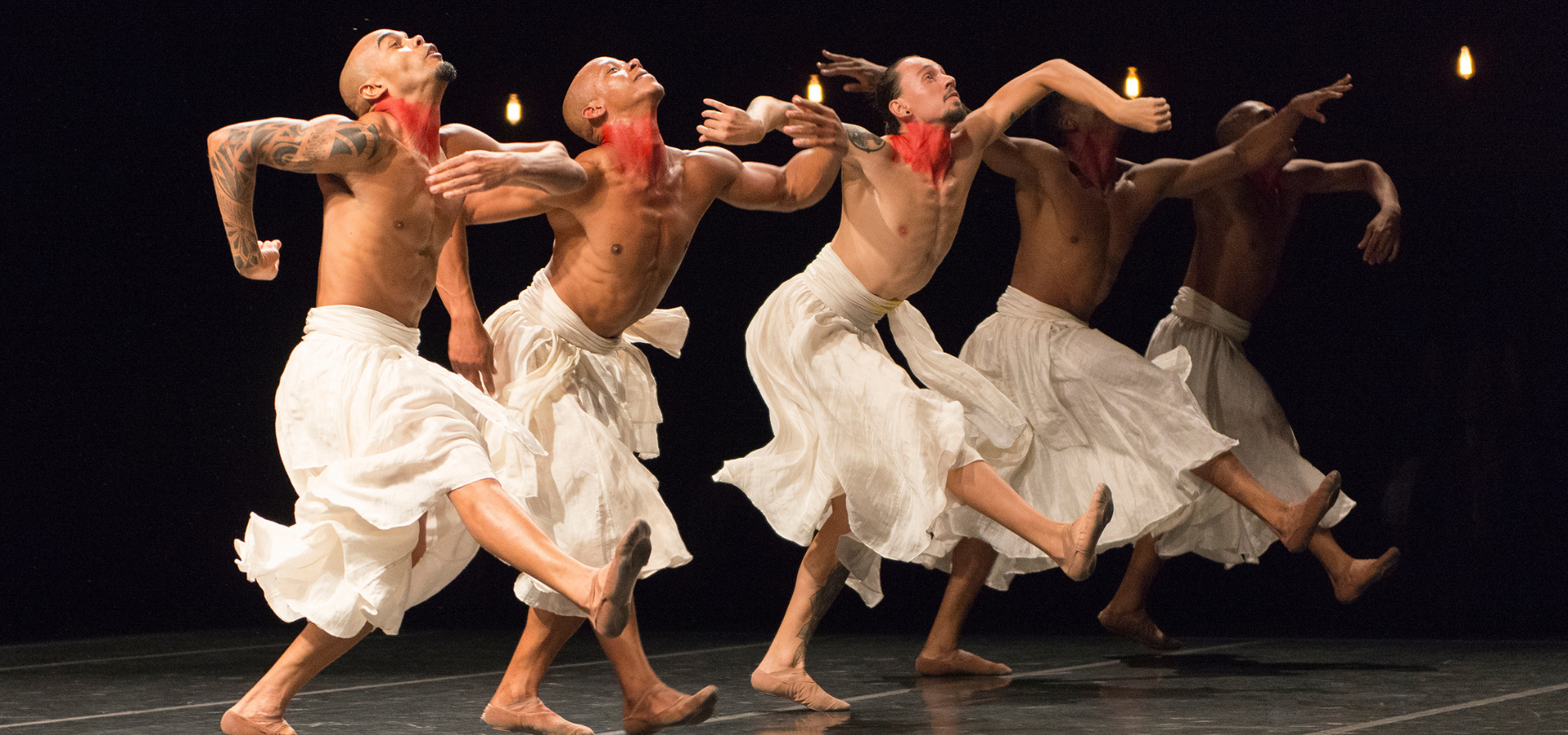
“Fractured History”: What is the Role of Appropriation in Art?
“Some of the best works that I’ve seen both allow you the transport and give you the disquiet so that you are suspended in a state of identification and distance.”
Produced and directed by Mina Girgis, Cal Performances’ Director of Education, Campus and Community Engagement; Directed by Maruf Noyoft; Edited by Diana Brodie. Full credits below.
In the context of this video, the term “appropriation” is used to describe any instance when an artistic element, form, or tradition is used by a creator who is not a member of the originating group. Here, UC Berkeley faculty and Illuminations artists explore the complexities surrounding the application of the “appropriation” label, whether it is always problematic, and to what extent deeming a practice appropriative might protect or limit creative expression.
Learn more about Illuminations: “Fractured History.”
This video features Julia Bullock, soprano and Cal Performances artist in residence; Beth Piatote, PhD, UC Berkeley Professor of Comparative Literature, Director of the Berkeley Arts Research Center; Debarati Sanyal, PhD, UC Berkeley Professor of French, Director of the Berkeley Center for Interdisciplinary Critical Inquiry; and Marié Abe, PhD, UC Berkeley Professor of Music.
Transcript
Julia Bullock:
Questions of appropriation are big and important. As a classical singer, we’re engaging with history.
Beth Piatote:
Appropriation is a really important question. What is that line between appreciation or fusion, or and appropriation and theft? That’s all going to be kind of murky.
Marié Abe:
Because it’s become such a colloquial term, people become paralyzed by what is creatively allowed or what is allowed for you to appreciate.
Debarati Sanyal:
And it’s asymmetrical. When we talk about appropriation, there is a tendency to just cancel rather than engage in the complexities.
And appropriation has been a fact of artistic transmission throughout the ages. It’s translation. It’s homage, right? It’s actually paying one’s respect to a particular tradition.
Beth Piatote:
As an Indigenous person, really appreciate the beauty of our forms, and there’s a big part of me that’s like, “I want everyone to know this story that comes from our culture.” And then I feel like, “Well, I can tell stories from my own culture. Can I tell stories of other cultures?”
Debarati Sanyal:
Music, for instance, I love when flamenco… meets hip hop. It’s seeking connections between different cultures that I think we shouldn’t give up on out of fear of being canceled for appropriating.
Marié Abe:
First, understand the creative process that led to appropriative gestures or practices in its own historical time. Not to give them any excuses, but what was being considered innovative at the time, what were some of the assumptions? How is authorship conceived in the source culture and then the new context.
Beth Piatote:
What are the possibilities of being able to think about what this new form is or what this new question is or set of questions that come out of bringing these forms together? I find that very exciting prospects.
Julia Bullock:
(About Olivier Messiaen’s Harawi) Going through this incredibly intense material, honestly, I did not know anything about arts practice of harawi at all, which is music and movement originated in the Andes Mountains. Messiaen was first exposed to this art form through an anthology, some of the lyrics and also the melodies Messiaen directly quoted. Messiaen, he’s one of those composers who wrote not just music but lyrics that are trying to deal with deeply personal things, in this case, I think a major loss, and find a way through whatever art form to process it.
Beth Piatote:
What was it for him about this art form that he wanted to create this fusion of two great cultural traditions? What will happen if they come together?
Julia Bullock:
When we started to talk about how to stage this work and how we even wanted to begin the kind of research process collectively, and I said it was really important for me to at least engage in some conversations with practitioners of harawi. And so I found two women who danced and sang, and I took a lot of notes. I think as long as we are responsibly engaging with material and then therefore that means looking at history very closely, then the question of appropriation and then the erasure that sometimes, or often, accompanies that cycle can stopped.
Debarati Sanyal:
Some of the best works that I’ve seen, both allow you the transport and give you the disquiet so that you are suspended in a state of identification and distance. I really value those works.
Beth Piatote:
Fracture helps us imagine a world in which these power dynamics don’t exist, and being in that place where those power dynamics don’t rule may be some place we need to go and think about.
Marié Abe:
I don’t think we can quite ever get beyond the questions of cultural appropriation. We probably should just have a chart of bigger questions that you might want to just think through before even conjuring the word cultural appropriation, because that’s just a quick term to evoke this big matrix of complex power relations.
Julia Bullock:
Part of the joy, at least I feel as a musician, I’m healing some of those fractures, or at least trying to rebuild some things.
Related Posts
There are no related posts yet. Check back soon!
“Fractured History”: Art as Historical Reference
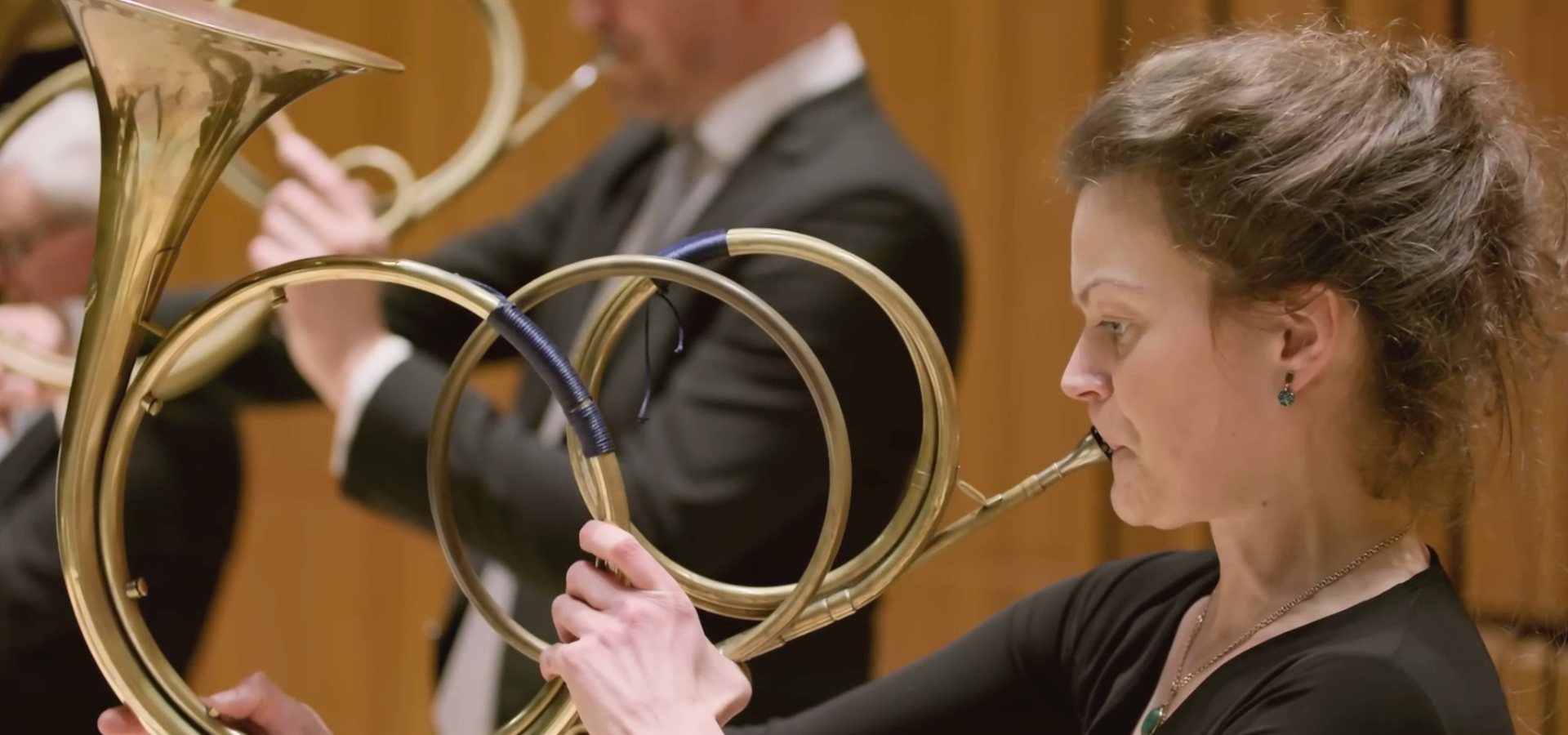
“Fractured History”: Art as Historical Reference
“You want to be transported into that world, which is not the same world as historical accuracy and verification.”
Produced and directed by Mina Girgis, Cal Performances’ Director of Education, Campus and Community Engagement; Directed by Maruf Noyoft; Edited by Mario DeCuir. Full credits below.
In this video, UC Berkeley professors and artists participating in Cal Performances’ presented season explore how we grapple with visual and performing artworks that recount historical events. While artwork is not meant to substitute for history books, it often plays a seminal role in public storytelling and narrative dissemination.
Learn more about Illuminations: “Fractured History.”
This video features David Ono, journalist and filmmaker, Story Boldly (Story Boldly’s Defining Courage comes to Zellerbach Hall April 4, 2025); Beth Piatote, PhD, UC Berkeley Professor of Comparative Literature, Director of the Berkeley Arts Research Center; Debarati Sanyal, PhD, UC Berkeley Professor of French, Director of the Berkeley Center for Interdisciplinary Critical Inquiry; Harry Bicket, harpsichordist and conductor of the English Concert (Handel’s Giulio Cesare in Egitto comes to Zellerbach Hall April 27, 2025); Marié Abe, PhD, UC Berkeley Professor of Music; and William Kentridge, stage director, draughtsman, performer and filmmaker (William Kentridge’s The Great Yes, The Great No comes to Zellerbach Hall March 14–16, 2025).
Transcript
David Ono:
There’s nothing better than seeing people moved. There’s nothing better than hearing from somebody, “I never knew that story. I need to look into that story further. I want to learn more.”
Beth Piatote:
The artist may capture what it really is to live with history, to live with the unwieldiness of history.
Debarati Sanyal:
You want to be transported into that world, which is not the same world as historical accuracy and verification.
Harry Bicket:
A lot of these pieces are based on historical fact, but they’re not there to teach a history lesson.
Marié Abe:
Creativity can then lead to critical thinking or questioning of whose voices have been erased, whose voices have been louder.
William Kentridge:
(Referencing William Kentridge’s The Great Yes, The Great No) He calls up the philosopher and psychoanalyst, Frantz Fanon, the Nardal sisters, even calls up Josephine Bonaparte, Napoleon’s wife who came from this tiny island of Martinique. We have a duet of Josephine Bonaparte and Josephine Baker, another transatlantic voyager.
Beth Piatote:
The historian is bound to chronological time. So an event that happened here, then its refractions may be felt over here. In a historical narrative, they may be separated.
Debarati Sanyal:
There is a way in which history is story also. Works of art that retell history, how do we approach that? It depends on what the work does. Is it really disinforming or is it by pulling different histories together, for example, provoking an illumination?
Beth Piatote:
If you’re a musician or an artist of another kind, you can put those events in intense juxtaposition. I think it’s much more difficult for the historian in a conventional historical narrative to be able to show the intensity of the past popping up into the present. Historians and artists share an ethic of making history bearable. What we see in art is it helps us pick up those historical pains.
David Ono:
(Referencing Story Boldly’s Defining Courage) I think the Nisei soldier story connects to all the other stories of color in America. They don’t sit on an island on their own. The story is so dynamic and it’s so moving, and it’s almost so unbelievable that it carries itself. That’s what I love about it. There’s no fiction here. Everything is accurate. Everything happened. All these people you hear about were real people, and there’s not one stitch of anything that is made up. It’s all fact. It all happened.
Harry Bicket:
(Referencing Handel’s Giulio Cesare in Egitto) The story that you’ll hear is more of a mixture between a romance, and a comedy, and a tragedy. The basis of the story is true, but the actual opera is more about the human elements of the story rather than the historic elements of the story.
Marié Abe:
If we go in with no knowledge, no curiosity, no questioning, and go in with the assumption that what you see on stage is the history with the capital H, then yeah, that could be a problem.
Debarati Sanyal:
Fictionality is part of art. That’s actually what makes histories so much more vivid when they’re actually being represented through art.
Beth Piatote:
Arts give us a way of bringing into our bodies and carrying forward history.
Related Posts
There are no related posts yet. Check back soon!
Artists and UC Berkeley Professors Discuss Illuminations: “Fractured History”

Artists and UC Berkeley Professors Discuss Illuminations: “Fractured History”
“History is always fractured. There’s a certain group that’s going to tell the story and, very likely, they’re going to tell their version of the story.”
Produced and directed by Mina Girgis, Cal Performances’ Director of Education, Campus and Community Engagement; Directed and edited by Maruf Noyoft. Full credits below.
Our understanding of history is neither static nor complete; rather, it is dynamic and ever-changing due to the malleability of our collective memory. Examining the evolutions in our historical narratives often entails re-evaluating our collective understanding of what is fact, and finding new sources and voices with the potential to add layers to our understanding. Through this year’s Illuminations theme of “Fractured History,” we aim to explore and expand our understanding of the past. Illuminations performances and public programs in partnership with campus thought leaders will investigate what gets lost in abridging complex events, how to “zoom out” to be more inclusive in historical perspective, and what role the arts might play in restoring valuable nuances in the way we view our past, present and future.
In this video, UC Berkeley professors and artists participating in Cal Performances’ presented season tease big ideas and considerations for engaging with the theme, and share learnings from their own work on the topic.
Learn more about Illuminations: “Fractured History.”
This video features Christine Philliou, PhD, UC Berkeley Professor of History; David Ono, journalist and filmmaker, Story Boldly (Story Boldly’s Defining Courage comes to Zellerbach Hall April 4, 2025); Martha Redbone, singer-songwriter (This Land is Our Land comes to Zellerbach Hall February 28, 2025); Beth Piatote, PhD, UC Berkeley Professor of Comparative Literature, Director of the Berkeley Arts Research Center; Debarati Sanyal, PhD, UC Berkeley Professor of French, Director of the Berkeley Center for Interdisciplinary Critical Inquiry; and William Kentridge, stage director, draughtsman, performer and filmmaker (William Kentridge’s The Great Yes, The Great No comes to Zellerbach Hall March 14–16, 2025).
Transcript
Christine Phillou:
History is a study of change over time, study of the past… and that we can tell from histories that are written, we can read much more about the time that the history’s being written than the time that it’s writing about.
David Ono:
History is always fractured. There’s a certain group that’s going to tell the story, and very likely they’re going to tell their version of the story.
Martha Redbone:
A lot of that story has been erased deliberately. As they always say, history is told by the victors.
Beth Piatote:
I think art is what makes it possible to enter into these histories that are so painful or unbearable otherwise.
Debarati Sanyal:
Let’s keep fracturing those histories, but also kind of recognizing in the breakages, all the ways in which histories connect and are entangled and have these long aftermaths.
William Kentridge:
We are on board a ship, the captain Paul Lemaire from Marseille bound for Martinique, June 1941, refugees escaping from Vichy, France. Communists André Breton, Claude Lévi-Strauss the anthropologist, and on board the ship also is the captain who in fact is Karen the Ferryman of the dead, who not only are transporting these people across the Atlantic, but is able to call up historical characters from the past and even some from the future to reflect on the shift between Europe and its colonial past.
Debarati Sanyal:
A figure that I thought was really interesting that Kentridge brings into this imagined exodus from occupied France is Frantz Fanon because this is someone who basically realized as a psycho analyst in colonized Algeria that the colonizers and the colonized both suffering from the violence of colonial occupation and from this position of quasi-statelessness, or exile at the very least, was combating and therefore entangling different histories of occupation and oppression, entangling them in the name of a transnational liberation struggle.
Martha Redbone:
I don’t like the stories of the past. They’re very painful stories, but they’re truth and it’s about the truth that has to come up, that people can talk about. When it comes to the work that I do, it’s not for me. It’s really sharing a little piece of something and the hope that it sparks conversation because that is what has been lacking and albeit painful, or they call it uncomfortable, truths.
Christine Phillou:
There are two different kinds of historical fractures. One is due to the fact that we’ve often had a dominant historical narrative, which leaves out important dimensions and perspectives, so that’s almost an intentional fracture versus the kind of fractures that are due to incomplete knowledge or incomplete evidence about a particular period.
David Ono:
Historically, our country at times has failed, sometimes catastrophically. And how we treated Japanese Americans during World War II was certainly one of those chapters. The beauty of this particular chapter is it does go back 80-something years, but it doesn’t go back too far to where all those people are gone. That’s how we can make up for it. There are still people who lived that era who can correct it, who can help us better understand it today as opposed to how we taught it immediately after in the decades to come. And this is a perfect example of how these guys are considered the greatest fighting unit in American military history, and yet they’re not in our history books. Why is that?
Beth Piatote:
For artists and to be able to enter into the fracture and be able to actually simultaneously heal and make it bigger or make it something else. There’s this transformative possibility of the fracture.
Christine Phillou:
Taking as many different kinds of evidence and perspectives to heal the fracture, right? To include the different versions and to address the power relations that went into making the dominant version, and then these sort of subversive or these competing versions or these new layers of history that were not perceived, let alone valued in the past and trying to arrive at some sort of fair and inclusive story.
Related Posts
There are no related posts yet. Check back soon!


